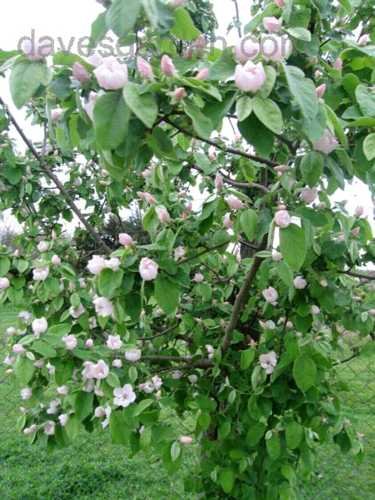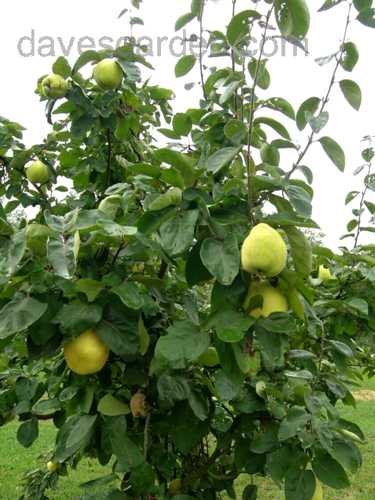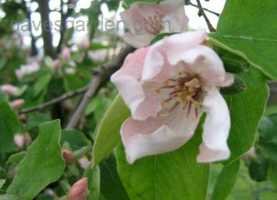





Quince, a very popular fruit in past generations, has fallen almost into obscurity and is now one of the most under-rated fruits. It is related to apples and pears and has a pear-shaped golden yellow ?pome? fruit. Quince fruit is used mainly in desserts and as fruit butters, jellies, relishes and chutneys.
The owl and the pussycat went to sea in a beautiful pea green boat. They dined on mince and slices of quince… Edward Lear, 1871. I learned those lines long before I ever knew what a quince is and today I still love the poem... and now the quince. Many home gardens today contain flowering “quince” which is not really a quince (Chaenomeles japonica) and grown for the bright peachy or coral colored spring blossoms, while ignoring the magnificent fruiting quince, Cydonia oblonga. Quince is the sole member of the genus Cydonia, native to southwest Asia and the Caucasus regions and grows here in USDA zones 5a-8b. It grows 15 to 20 feet tall and 10 to 12 feet wide, doing best in light shade to full sun. They should be planted in a sheltered location as they respond poorly to rapid changes in temperatures.
Many home gardens today contain flowering “quince” which is not really a quince (Chaenomeles japonica) and grown for the bright peachy or coral colored spring blossoms, while ignoring the magnificent fruiting quince, Cydonia oblonga. Quince is the sole member of the genus Cydonia, native to southwest Asia and the Caucasus regions and grows here in USDA zones 5a-8b. It grows 15 to 20 feet tall and 10 to 12 feet wide, doing best in light shade to full sun. They should be planted in a sheltered location as they respond poorly to rapid changes in temperatures.
Quince flowers are pale pink to white and bloom in mid spring to early summer. For the most part, quinces are self-fruitful. So, all you need is one plant in order to harvest fruits. A few varieties may require cross-pollination. For that reason, check the catalog description before choosing a variety. The immature fruit is rather furry but most of that ‘felty’ feel rubs off as the fruit matures in late autumn. As it matures, the fruit changes from green to yellow with a hard perfumery flesh and is seldom subject to bird damage although fire blight can be a problem. Unlike flowering quince, fruiting quince has thornless and gnarled branches offering winter interest.
The seeds from quince are sometimes viable if allowed to ripen and dry before sowing outside in fall or germinated in damp paper towels in spring. Quince may also be propagated by softwood cuttings and by air layering.
Culinary Uses
Quince paste, known in the 17th century as quiddany or cotoniack, is sometimes found in the jelly section of the supermarket but all quince recipes are easily made at home. Quince paste was my first taste of this fruit, and it’s like a block of firm jello, delicious served with a mild cheese or even a blue cheese. Quince must be cooked and the longer they cook, the deeper the reddish color becomes. Poach them in syrup with cardamon and cinnamon, or orange and lemon peel, or a fruit flavored brandy. Make a compote by adding stewed dried prunes and apricots. Also makes good jellies, relish, butters and chutneys. See a cake recipe below.
Other Uses
Quince leaves were once used in the tanning process as they contain high levels of tannin. Mucilage obtained from the seed coat is used as a gum Arabic substitute in cosmetics and eye lotions. Herbal medicines from quince were used for sore throats, and inflammations of the stomach and bowels.
Cultivars
Traditionally, only a handful of quince cultivars have been grown in the United States, but their ranks are swelling thanks to ARS researchers at the National Clonal Germplasm Repository (NCGR) in Corvallis, Oregon. Over the past decade, NCGR scientists have expanded a modest quince collection into one of the world's finest. [1]
Champion - Productive bearer of large fruit with tender flesh and a delicate flavor. Aromatnaya - (Experimental here) From S. Russia. Fruit is said to be edible fresh. Good disease resistance so far. Pineapple - Bred in CA and named for its pineapple -like flavor. Portugal- (Experimental here) Ripens early. Fruit turns red when cooked. Prefers a pollinator. Smyrna - A large fruited variety with good flavor. [2]
'Angers', 'Orange', 'Pineapple', 'Champion', and 'Smyrna' are generally available in the US. See some vendors below.
Many Thanks to Philomel for her lovely quince photos from PlantFiles and to GardenGuyKin for his.
Footnotes:
[1] http://findarticles.com/p/articles/mi_m3741/is_1_55/ai_n17134319
SomeSeedling Sources
http://www.hiddenspringsnursery.com/plants.html#Quince
http://www.tytyga.com/category/Quince+Trees
http://www.agroforestry.co.uk/ansample.html
L E Cooke Co, 26333 Road 140, Visalia, CA 93292. (Wholesale only).
Northwoods Retail Nursery, 27635 S.Oglesby Rd, Canby, OR 97013, USA. Tel: 503-266-5432
Quince and Almond Cake
(from Anneka Manning's Good Food)
100g (3.5 ozs.) softened unsalted butter
1/2 cup castor (fine) sugar
2 eggs
1/3 cup plain flour
1 tsp baking powder
1 cup almond meal
1 cup poached quinces, plus more slices for the top of the cake
A few tablespoons of liquid from the poached quinces, or apricot jam, for glazing
- Heat oven to 170°C (~340ºF). Line a springform baking tin - Anneka suggests 20cm (7-3/4”), but I like to use an 18cm (7”) tin, just because I like the look of smaller, high cakes.
- Cream butter and sugar together until pale and creamy. Beat in eggs one at a time.
- Sift together the flour and baking powder, and stir in the almond meal. Use a large metal spoon to fold dry ingredients into butter mixture.
- Slice the cup of quinces into thin slices and then fold into cake mixture.
- Pour batter into prepared tin and smooth the surface a little. Slice remaining quinces to an equal thickness and arrange (patterned or as you please) on the top of the batter.
- Bake for 40 minutes or until it can be cleanly skewered. Let cool for a few minutes before removing the outside of the tin.
- Warm the quince liquid or jam in a small saucepan and brush lovingly over the top of the cake to glaze. The liquid will mostly soak in but will still give a wonderful warm glow to the cake.
This cake is made to be eaten warm, with cream, for afternoon tea, or for after dinner, or actually for anytime at all. It rarely lasts longer than a day in our house as it is one of the few cakes that we all love. In fact, I shall be making another one soon, the last one was so good!
Buy the Green House and the Sheds From Online Stores
Benefits of Availing the best SC pest control and SC extermination Services
Choosing the Best in Commercial and Residential Pest Control
How to Create Beautiful Landscaping and Garden Designs at Reasonable Prices
Doing All The Gardening And Eating Healthy
Shimano Clarus: The New Sleek And Beautiful Shimano Rods In The Garden
Copyright © www.100flowers.win Botanic Garden All Rights Reserved